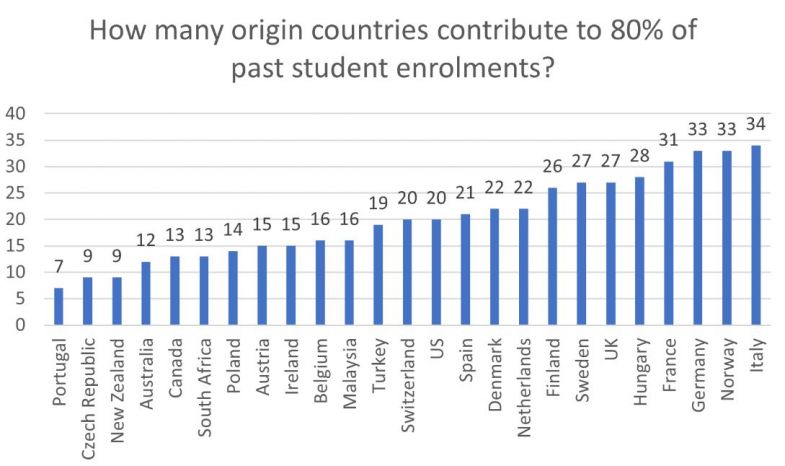English-speaking countries such as Australia, New Zealand and Canada have some of the least diverse international student populations, new research warns.
However, it found that current student interest comes from a much broader range of sources to these nations than past enrolments.
The report, by Dutch international education marketing company Studyportals, uses estimates from the United Nations Educational, Scientific and Cultural Organization (Unesco) and the Organisation for Economic Co-operation and Development (OECD) to give a global picture of student mobility based on past enrolments.
“The need to diversify is now greater than ever before as universities, competing globally, can no longer afford to be reliant on just a few source countries for their international student bodies,” the authors write.
The research found that 14 countries make up half of all international student enrolments, with numbers mainly driven by China and India – though their share is not equally distributed.
Studyportals examined how many origin countries contribute to 80 per cent of past student enrolments at the top 25 global destinations.
It found that western European countries – such as Italy (34 sources), Germany (33) and France (31) – were among the most diverse and in a “very favourable position”.

Source: Studyportals
“They are located in an interconnected network of different nationalities, with large expat communities, and often low-tuition-fee programmes open to internationals,” it says.
Meanwhile, eastern European countries – “latecomers in internationalisation” – were found to be less diverse and more dependent on neighbouring countries, but still attracted broad student interest and were regarded as well positioned for expansion.
However, Canada (13), Australia (12) and New Zealand (nine) had some of the least diverse international student populations.
“Despite being world-known destinations offering world-class education, these countries are overly reliant on just a handful of origin countries,” authors say.
Only Portugal (seven) and the Czech Republic (nine) had students from fewer origin countries.
By comparison, 80 per cent of the UK’s past enrolments came from 27 countries, though it benefits from being less geographically isolated.
Cara Skikne, one of the report’s authors, said about half of those countries are in Europe – though separate figures reveal fewer EU students are coming to the UK.
“An over-reliance on a few source countries for international students creates risk for universities in the face of uncertainties like geopolitical shifts, policy changes or border closures,” she told Times Higher Education.
Last year, Vivienne Stern, chief executive of Universities UK, urged British and Australian universities to prepare for a “catastrophe” in relations with China, while the governments of all these anglophone countries have expressed desires to diversify their student bodies.
Studyportals also tracks the anonymous search behaviour of 52 million prospective students to determine how many origin countries contribute to 80 per cent of student interest in English-taught programmes. It noted that data from China are absent due to internet restrictions.
For the UK and other western European success stories, it tracks quite evenly with past enrolments. But there appears to be “untapped demand” in Canada, Australia and New Zealand where current interest is almost twice as diverse as previous enrolments.
In Australia, demand appears to be even more diverse for the Group of Eight, the country’s most research-intensive universities.
Register to continue
Why register?
- Registration is free and only takes a moment
- Once registered, you can read 3 articles a month
- Sign up for our newsletter
Subscribe
Or subscribe for unlimited access to:
- Unlimited access to news, views, insights & reviews
- Digital editions
- Digital access to THE’s university and college rankings analysis
Already registered or a current subscriber? Login








